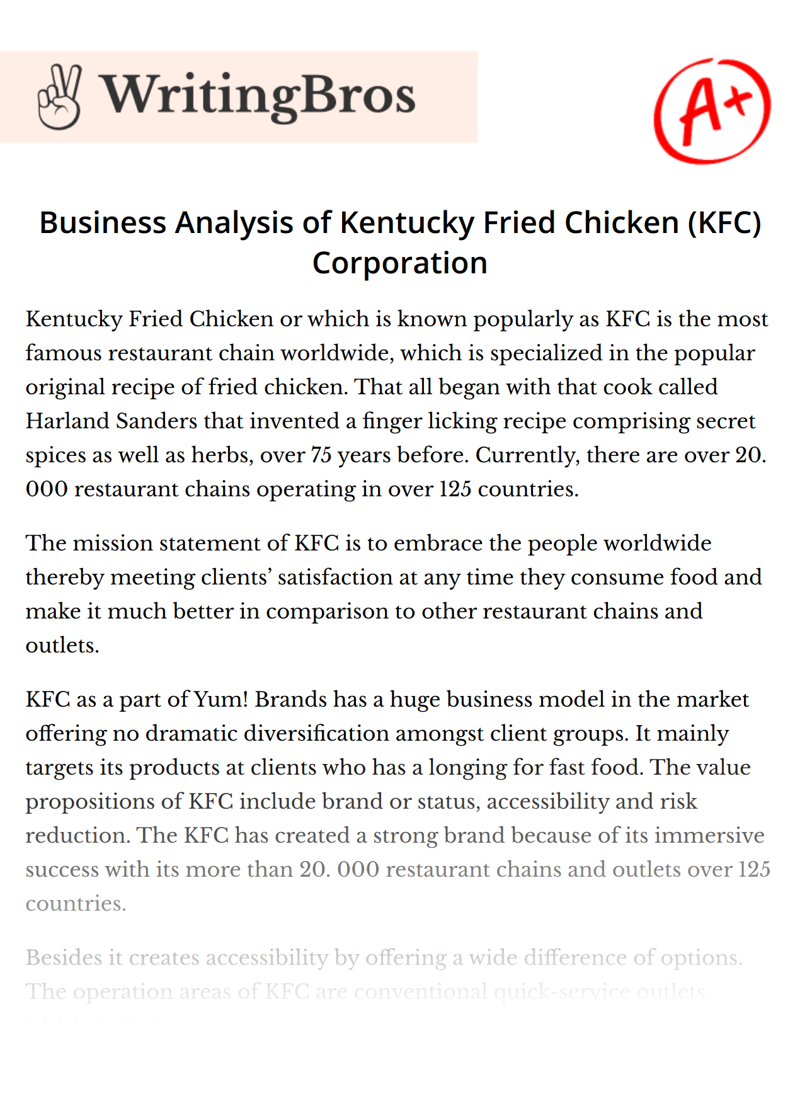Business Analysis of Kentucky Fried Chicken (KFC) Corporation

Kentucky Fried Chicken or which is known popularly as KFC is the most famous restaurant chain worldwide, which is specialized in the popular original recipe of fried chicken. That all began with that cook called Harland Sanders that invented a finger licking recipe comprising secret spices as well as herbs, over 75 years before. Currently, there are over 20. 000 restaurant chains operating in over 125 countries.
The mission statement of KFC is to embrace the people worldwide thereby meeting clients’ satisfaction at any time they consume food and make it much better in comparison to other restaurant chains and outlets.
KFC as a part of Yum! Brands has a huge business model in the market offering no dramatic diversification amongst client groups. It mainly targets its products at clients who has a longing for fast food. The value propositions of KFC include brand or status, accessibility and risk reduction. The KFC has created a strong brand because of its immersive success with its more than 20. 000 restaurant chains and outlets over 125 countries.
Besides it creates accessibility by offering a wide difference of options. The operation areas of KFC are conventional quick-service outlets, which include carry-out, dining, delivery and drive-thru, and unconventional sections, which are mainly kiosks as well as units with a limited menu and those kiosks are located in airports, malls, service stations of gas, subways, stadiums, train stations, colleges and amusement parks.
Also, KFC decreases risk by established high quality as well as safety standards in the food safety, nutrition and ethical sourcing segments. When it comes to food safety, KFC keeps maintenance of food safety systems in its service areas with strict standards and provides training in terms of handling a product, health of workers, managing the temperature and ingredient of product and preventing the cross-contamination of product. This all are done on a daily activity starting from the procurement of raw product till preparation and serving of ready food. For the ethical sourcing, KFC keeps a maintenance of minimum standards for its suppliers in order to guarantee that its production and livestock are procured in environmentally-friendly ways. Besides, in terms of nutrition, it targets to proactively improve the nutrition value of its food content in order to ensure that its products are high-quality and guarantee to be a sensibly-balanced diet part.
History
As it was aforementioned, it all started with that cook named Harland Sanders, who was born in 1890 and was grown up in the outskirts of Henryville, Indiana. Harland Sanders had tough childhood period because he had to work at a canning plant and had to take care of his two siblings due to the early death of his father while he was at the age of 5. His mother taught him the cooking skills when he turned to age of 7. He had to leave his family while he was at 13 and started to work in a number of professions with mixed success such as worker in railroads and salesman of insurance company. At the age of 40, a Shell filling station would be taken over by him in the city of North Cabin and he began converting the storeroom into the tiny dining area and started to sell fried chicken. The preliminary dissatisfaction of Sanders was that it took around 35 minutes to prepare chicken although he did not want to fry it deeply. In his opinion, a much rapid process was that it yielded dry as well as crusty chicken that was cooked unevenly. Without doubt, preparing the chicken in advance of order would cause the was at the end of working day that he did not want to do it. However, the first release of commercial pressure cookers in 1939 not only helped him to cut the time of production so that to make it comparable to deep frying but also maintained the quality of pan-fried chicken. Sanders never announced that recipe publicly but instead claimed that he used just mixture of salt and pepper.
Cite this Essay
To export a reference to this article please select a referencing style below

